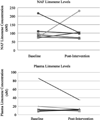Safety and Feasibility of Topical Application of Limonene as a Massage Oil to the Breast
- PMID: 24236248
- PMCID: PMC3824622
- DOI: 10.4236/jct.2012.325094
Safety and Feasibility of Topical Application of Limonene as a Massage Oil to the Breast
Abstract
Background: Limonene, a major component in citrus oil, has demonstrated anti-cancer effects in preclinical mammary cancer models. However, the effective oral dose translates to a human dose that may not be feasible for chronic dosing. We proposed to evaluate topical application of limonene to the breast as an alternative dosing strategy.
Materials and methods: We conducted a mouse disposition study to determine whether limonene would be bio available in the mammary tissue after topical application. SKH-1 mice received topical or oral administration of limonene in the form of orange oil every day for 4 weeks. Plasma and mammary pads were collected 4 hrs after the final dosing. We also conducted an exploratory clinical study to evaluate the safety and feasibility of topically applied limonene in the form of orange oil to the breast. Healthy women were recruited to apply orange oil containing massage oil to their breasts daily for four weeks. Safety and feasibility were assessed by reported adverse events, clinical labs, and usage compliance. Pre and post-intervention nipple aspirate fluid (NAF) and plasma were collected for limonene concentration determination.
Results: The mouse disposition study showed that topical and oral orange oil administration resulted in similar mammary tissue disposition of limonene with no clinical signs of toxicity. In the clinical study, the topical application of limonene containing massage oil to the breast was found to be safe with high levels of usage compliance for daily application, although NAF and plasma limonene concentrations were not significantly changed after the massage oil application.
Conclusions: Our studies showed that limonene is bio available in mammary tissue after topical orange oil application in mice and this novel route of administration to the breast is safe and feasible in healthy women.
Keywords: Limonene; Safety; Topical Application.
Figures


Similar articles
-
Adipose tissue accumulation of d-limonene with the consumption of a lemonade preparation rich in d-limonene content.Nutr Cancer. 2010;62(6):783-8. doi: 10.1080/01635581003693066. Nutr Cancer. 2010. PMID: 20661827 Free PMC article.
-
Human breast tissue disposition and bioactivity of limonene in women with early-stage breast cancer.Cancer Prev Res (Phila). 2013 Jun;6(6):577-84. doi: 10.1158/1940-6207.CAPR-12-0452. Epub 2013 Apr 3. Cancer Prev Res (Phila). 2013. PMID: 23554130 Free PMC article. Clinical Trial.
-
Mouse skin tumor promoting activity of orange peel oil and d-limonene: a re-evaluation.Carcinogenesis. 1986 Dec;7(12):2047-9. doi: 10.1093/carcin/7.12.2047. Carcinogenesis. 1986. PMID: 3096589
-
Monoterpenes in breast cancer chemoprevention.Breast Cancer Res Treat. 1997 Nov-Dec;46(2-3):191-7. doi: 10.1023/a:1005939806591. Breast Cancer Res Treat. 1997. PMID: 9478274 Review.
-
D-Limonene: safety and clinical applications.Altern Med Rev. 2007 Sep;12(3):259-64. Altern Med Rev. 2007. PMID: 18072821 Review.
Cited by
-
Effect of d-limonene and its derivatives on breast cancer in human trials: a scoping review and narrative synthesis.BMC Cancer. 2021 Aug 6;21(1):902. doi: 10.1186/s12885-021-08639-1. BMC Cancer. 2021. PMID: 34362338 Free PMC article.
-
Massage with or without aromatherapy for symptom relief in people with cancer.Cochrane Database Syst Rev. 2016 Jun 3;2016(6):CD009873. doi: 10.1002/14651858.CD009873.pub3. Cochrane Database Syst Rev. 2016. PMID: 27258432 Free PMC article.
-
Metabolomic characterization of nipple aspirate fluid by (1)H NMR spectroscopy and GC-MS.J Proteome Res. 2014 Feb 7;13(2):883-9. doi: 10.1021/pr400924k. Epub 2014 Jan 7. J Proteome Res. 2014. PMID: 24364541 Free PMC article.
-
Phytochemical and Therapeutic Potential of Citrus grandis (L.) Osbeck: A Review.J Evid Based Integr Med. 2021 Jan-Dec;26:2515690X211043741. doi: 10.1177/2515690X211043741. J Evid Based Integr Med. 2021. PMID: 34657477 Free PMC article. Review.
-
Expression of epidermal growth factor, transforming growth factor-β1 and adiponectin in nipple aspirate fluid and plasma of pre and post-menopausal women.Biomark Res. 2013 Apr 15;1(1):18. doi: 10.1186/2050-7771-1-18. Biomark Res. 2013. PMID: 24252368 Free PMC article.
References
-
- Elson CE, Maltzman TH, Boston JL, Tanner MA, Gould MN. Anti-Carcinogenic Activity of d-Limonene during the Initiation and Promotion/Progression Stages of DMBA-Induced Rat Mammary Carcinogenesis. Carcinogenesis. 1988;Vol. 9(No. 2):331–332. - PubMed
-
- Haag JD, Lindstrom MJ, Gould MN. Limonene-Induced Regression of Mammary Carcinomas. Cancer Research. 1992;Vol. 52(No. 14):4021–4026. - PubMed
-
- Maltzman TH, Hurt LM, Elson CE, Tanner MA, Gould MN. The Prevention of Nitrosomethylurea-Induced Mammary Tumors by d-Limonene and Orange Oil. Carcinogenesis. 1989;Vol. 10(No. 4):781–783. - PubMed
-
- Gould MN, Moore CJ, Zhang R, Wang B, Kennan WS, Haag JD. Limonene Chemoprevention of Mammary Carcinoma Induction following Direct in Situ Transfer of V-Ha-Ras. Cancer Research. 1994;Vol. 54(No. 13):3540–3543. - PubMed
-
- Elegbede JA, Elson CE, Tanner MA, Qureshi A, Gould MN. Regression of Rat Primary Mammary Tumors following Dietary d-Limonene. Journal of the National Cancer Institute. 1986;Vol. 76(No. 2):323–325. - PubMed
Grants and funding
LinkOut - more resources
Full Text Sources
Other Literature Sources
